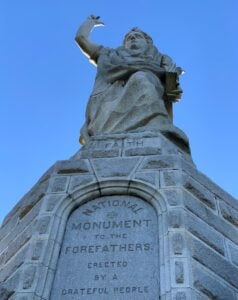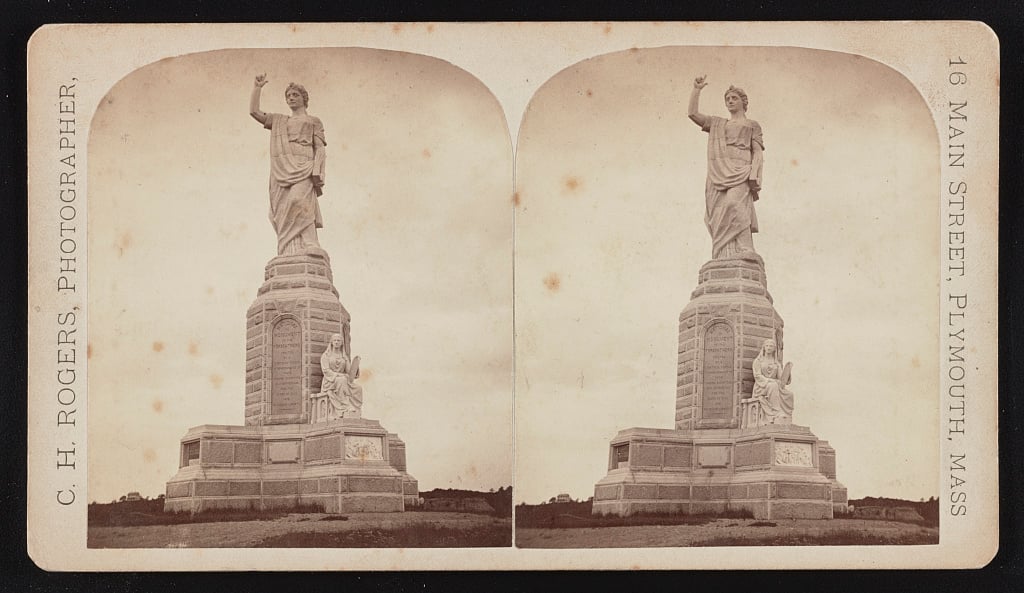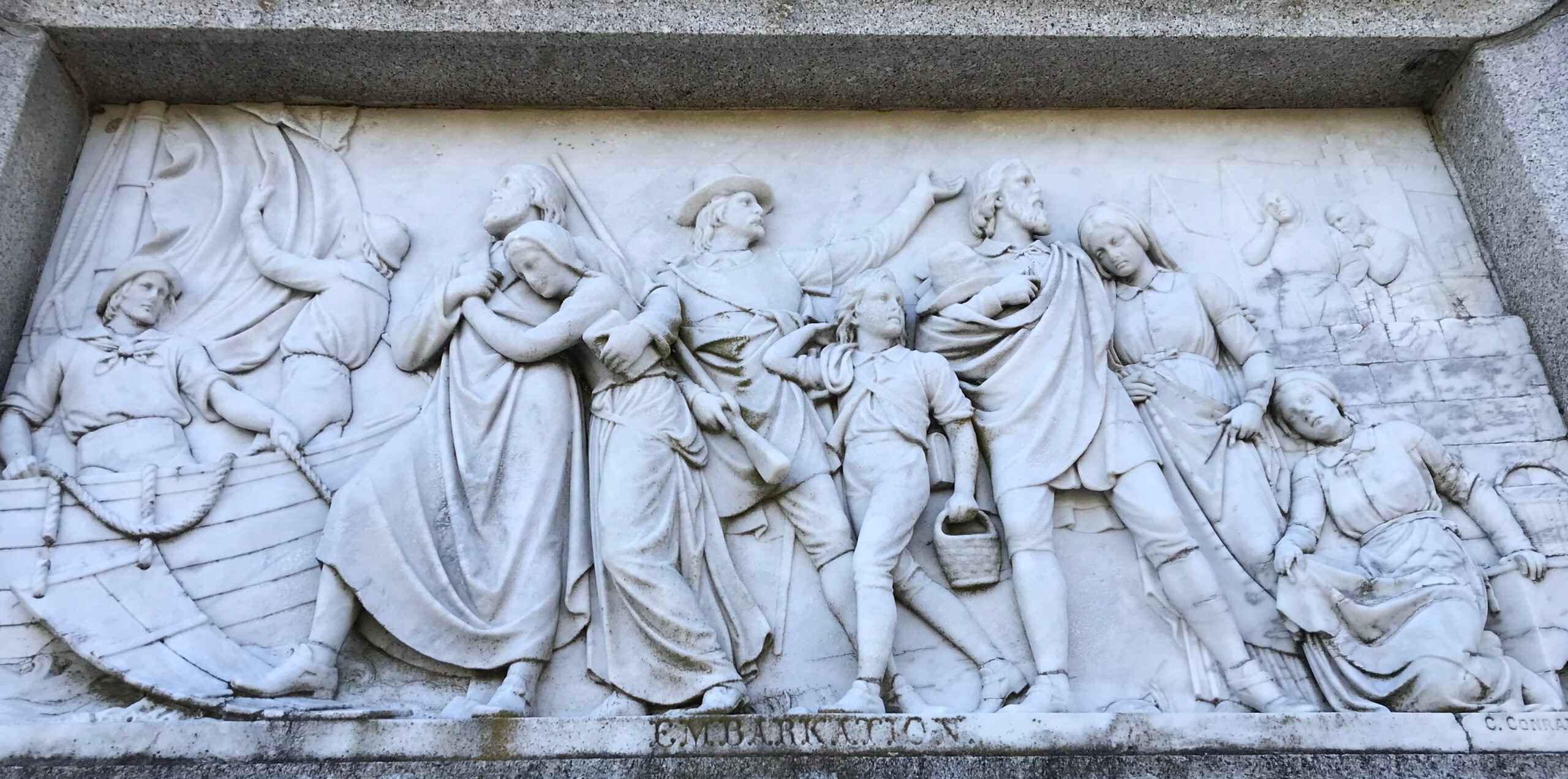Now faith is the substance of things hoped for, the evidence of things not seen.
– Hebrews 11: 1
A comment on my recent post, Seeing double, reminded readers of yet another tribute honoring the Pilgrim legacy, the National Monument to the Forefathers. The gentleman who commented called the monument one of Plymouth’s best kept secrets. Its location, off-the-beaten path, on an 11-acre site in a residential neighborhood, does make it less-visited than the iconic Mayflower and Rock.
It has been said that the monument’s sheer size and multitude of visual elements, the centerpiece of which is the figure of Faith, overwhelms modern sensibilities. It is not signposted on the highway, Route 3, but only on Route 3A, the secondary road into Plymouth, and since that is the road I take, I always make the “detour” up the hill to visit. (When the leaves are off the trees, the approach up the hill and first sight of the monument can be startling.) For me, this colossus – with open space all around so that it can be fully appreciated against an open sky – not only honors an historic event but gives visual expression to enduring virtues: the principles and essential rights upon which the American nation was founded. And if one “reads” the monument from top to bottom, from Faith – that inner light guiding one’s path – all else flows. The complexity of the National Monument to the Forefathers, considered in that simplicity, becomes not quite so overwhelming.
No sooner had the Pilgrim Society – whose origin was rooted in the Old Colony Club – been formally organized in 1820 during the 200th anniversary of the Pilgrim landing when discussion began about suitable, permanent monuments to perpetuate the Pilgrim legacy. Within four years the cornerstone had been laid for Pilgrim Hall, but it would be thirty years before Society members would vote, in 1850, to build a monument at Plymouth Rock to commemorate the landing. The project seems to have stalled, but by August 1853, during a grand celebration recognizing the anniversary of the departure of the Pilgrims from Delft Haven, interest was reawakened in the monument. In due time, a decision was made to build not one but two monuments, a “simpler” tribute sheltering the Rock and another, a grander and more aspirational tribute, on an “elevated eminence” in the old town. What had taken place to prompt the Pilgrim Society to suddenly take on two projects?
On 2 August 1859, the cornerstones for both monuments (into which leaden boxes with objects of historical interest were placed) were laid with Masonic and religious ceremony. The Victorian canopy at Plymouth Rock was finally completed in 1867, though it was razed and replaced during the tercentenary in 1920 by the majestic McKim, Mead and White portico that now commands Plymouth’s waterfront. Not until 1 August 1889 was the second monument, the solid granite National Monument to the Forefathers – referred to in the newspapers as the Pilgrim Monument but not to be confused with the later Pilgrim Monument built at Provincetown – dedicated with great fanfare on Allerton Street, a summit from which every place meaningful to the Pilgrims – Provincetown, Clark’s Island, Kingston, Duxbury, and Marshfield – could be seen. The site and its expansive view were in every way integral to the monument’s original concept.
The designer of both monuments was Boston architect and artist Charles Howland Hammatt Billings (1818-1874). Born in Milton, Massachusetts, Hammatt, as he was known, was the son of Ebenezer Billings (1796-1837) and Mary D. Janes (1795-1864). The Billings family had deep roots in Milton, where ancestors kept a public house as early as 1681. By Ebenezer’s day the establishment at the foot of Blue Hill was described as an “excellent tavern, boarding house and fruit gardens,” and one of the most fashionable retreats in the area.
By the early 1840s, he had opened his own firm, often working with his brother Joseph.
The oldest of six children, Hammatt, while still a youth, was apprenticed to an engraver, later joining an architectural firm where he assisted in preparing drawings for Boston’s Custom House on State Street. By the early 1840s, he had opened his own firm, often working with his brother Joseph. He was both prolific and versatile, designing buildings such as the Boston Museum on Tremont Street, a Barnumesque theatre, wax museum, art gallery, natural history museum, and zoo; the Robert Gould Shaw funerary monument at Mount Auburn Cemetery, built in 1848 as the centerpiece of the family plot; and College Hall, the single, grand building housing students, faculty, classrooms and laboratories that was Wellesley College for nearly forty years. In addition to his architectural projects, Billings was an accomplished painter in oils and watercolor, and an illustrator of books and magazines, his work appearing in Gleason’s Pictorial and Ballou’s Pictorial, Stowe’s Uncle Tom’s Cabin, and Tennyson’s Poems.
Well-known in his day, the Billings name and his projects have since been eclipsed by more prominent names and monuments, and few of his commissions remain today, the Boston Museum having been razed in 1903, College Hall destroyed by fire in 1914, and the remodeled vestibule of the Boston Athenæum likely removed by 1915. Other projects for which Billings had submitted plans, a Soldiers and Sailors Monument on Boston Common and a grand Minuteman statue for Lexington, were thwarted, though the monuments were eventually designed and completed by others, the Civil War monument by sculptor Martin Milmore and The Minute Man, by Daniel Chester French (1850-1931), installed at Concord.
Reflecting on the decision by the Pilgrim Society after 1853 to commission two monuments at Plymouth, it seems that the death of lawyer, statesman, and orator Daniel Webster in October 1852 played a part. In 1820, Webster had electrified an audience of more than 1,200 at First Church with his two-hour, soul-stirring speech, “First Settlement of New England,” reminding New Englanders of their storied past and tying the Pilgrim legacy to America’s destiny.
Following Webster’s death, Hammatt Billings had conceived of an imposing monument to Webster, in the colossus tradition, gracing the Boston Public Garden. Though the monument was never realized, by 1854 Billings, who may have been tipped off by Pilgrim Society insiders to their plans for a monument at Plymouth Rock, was re-envisioning his Webster monument as a Forefathers Monument, even before the call for proposals had been made public by the Society. His “grand design” was widely circulated with the persuasive argument that no monument was too impressive (or costly) given the noble deeds and heroism of the Pilgrim fathers and the gratitude owed to them by all Americans. Though proposals were submitted by other architects, Billings’ patriotic appeal won out. The Society recognized, however, that his design would be unsuitable to the waterfront site. Thus, a second location was sought to accommodate his Pilgrim Monument, originally conceived to be 150 feet tall.
In the name of the Pilgrim Society, Billings took responsibility for soliciting funds and acquiring the site. The nationwide grassroots fundraising effort, though hindered by the Civil War, assured that the monument would speak to a national consensus, though many entertained doubts that the monument would ever be built. Premiums were offered to donors, including engraved certificates and small replicas of the monument. Among the 11,000 donors, including individuals and organizations, was President Abraham Lincoln, who sent a ten-dollar contribution. In the end, the cost of the monument was $150,000.
From her forty-five-foot octagonal pedestal Faith, put into position in 1877, towers thirty-six feet skyward, her foot resting on Plymouth Rock, her left hand holding the Bible, her right hand pointing to Heaven. The visual expression of our national origin – faith having inspired and guided the Pilgrim journey – she is 216 times life size and weighs 180 tons. One feels downright Lilliputian next to her. At a cost of $31,300, Faith was the gift of Plymouth native and Union Pacific Railroad president Oliver Ames, Jr. (1807-1877).
Four buttresses project from the pedestal, each with a seated allegorical figure representing the principles upon which the Pilgrims founded their colony. The figures – each carved from single blocks of Hallowell, Maine granite – represent Morality, coupled with amplifying figures of Prophet and Evangelist; Law, coupled with Justice and Mercy; Education, coupled with Wisdom and Youth; and Liberty (originally conceived as Freedom), coupled with Peace and Tyranny. Beneath each of the four figures is a bas-relief scene, in white marble, illustrating episodes from Pilgrim history. Embarkation at Delft-Haven is paired with Morality; Signing of the Social Compact in the Cabin of the Mayflower with Education; Landing at Plymouth with Liberty; and Treaty with the Indians with Law. Rounding out the visual features of the monument are four inscription panels: a dedication; the names, on two panels, of the Mayflower passengers; and Governor William Bradford’s well-known “one small candle” quote, the last addition to the monument.
One newspaper report noted that he had given his life cheerfully to the monument, without suitable monetary reward.
Sadly, Hammatt Billings, who died in 1874 while visiting his brother in New York, did not live to see his crowning achievement completed, one of the few examples of public art by which his talents might now be assessed. He came home to Milton and was buried in a family plot in the Old Section of the Milton Cemetery. One newspaper report noted that he had given his life cheerfully to the monument, without suitable monetary reward. The power of his own faith carried the project to its fulfillment, the work finally completed, with a few changes from the original design – most significantly a reduction in size and the elimination of an interior staircase – by Hammatt’s brother, Joseph, and a group of sculptors who contributed figures and reliefs.
In 1974, the monument was added to the National Register of Historic Places and in 2001 it was deeded by the Pilgrim Society to the Commonwealth of Massachusetts. Along with Plymouth Rock, the two monuments now constitute Pilgrim Memorial State Park. It is perhaps fitting that the two sites, originally linked to Hammatt Billings, are linked once again.
If I might offer an incidental comment about the monument, it is that the site could benefit from one or two modest, well-placed interpretive panels to illuminate the visitor experience, especially since this site isn’t as straightforward as others (like the Mayflower replica and the Rock), and trying to assimilate the monument is rather like trying to get one’s arms around a mountain. A small kiosk at the site now displays a laminated card with some explanation, but explanations of the symbolism of this monument and its location could be strengthened to tie together the full Pilgrim legacy, from the perilous journey of that solitary vessel to all that flowed from it. Nonetheless, the National Monument to the Forefathers is an exquisite work of human accomplishment and tribute and can be admired as such with little else.
Share this:

About Amy Whorf McGuiggan
Amy Whorf McGuiggan recently published Finding Emma: My Search For the Family My Grandfather Never Knew; she is also the author of My Provincetown: Memories of a Cape Cod Childhood; Christmas in New England; and Take Me Out to the Ball Game: The Story of the Sensational Baseball Song. Past projects have included curating, researching, and writing the exhibition Forgotten Port: Provincetown’s Whaling Heritage (for the Pilgrim Monument and Provincetown Museum) and Albert Edel: Moments in Time, Pictures of Place (for the Provincetown Art Association and Museum).View all posts by Amy Whorf McGuiggan →


